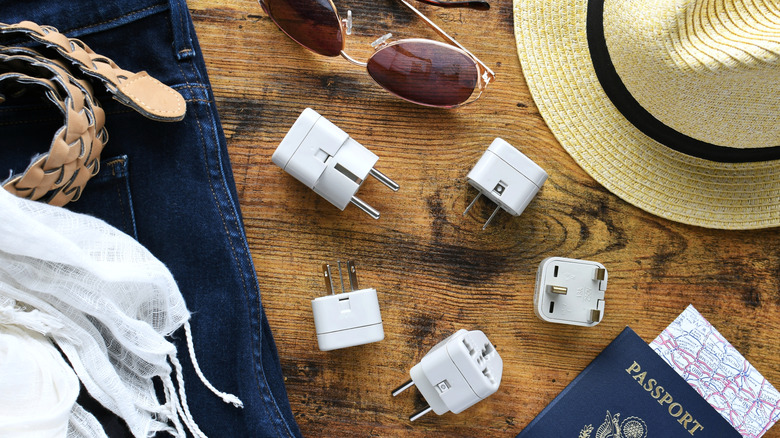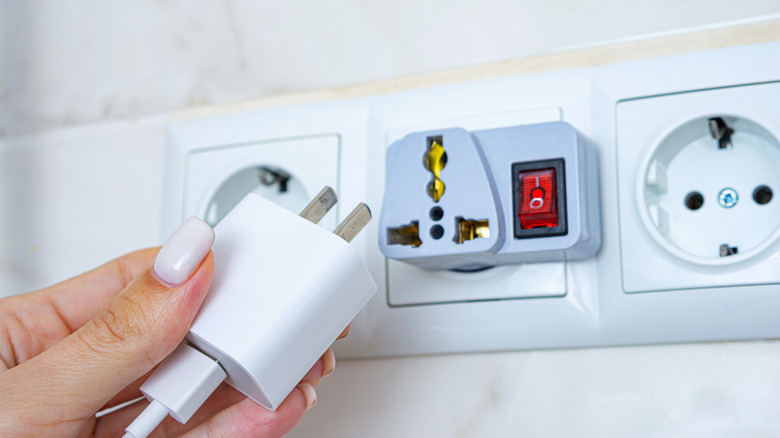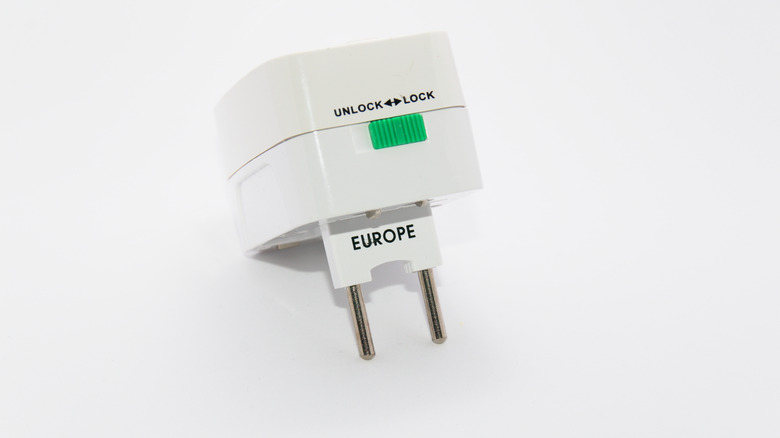Why Your American Charger Plug Won't Work In Europe (And How To Fix That)
When we're stateside, we tend to take the power outlets we use to charge our devices for granted. After all, there's not a whole lot to think about. The chargers that come with our devices are designed to work in standard U.S. outlets, so there's not much guesswork. Plug your device in, and it starts charging. However, if you've ever traveled to Europe, you know things are different. Whether you're visiting London or Berlin, that trusty charger from your favorite brand won't fit the outlet, and even if you somehow manage to plug it in, it won't work safely without the right setup. That's because the chargers we use in the U.S., or more specifically, the plugs attached to them, aren't compatible with European outlets.
While looking at your charger plug and a European outlet, you might think the difference is just a matter of shape, but there's more to it than that. European and U.S. outlets also operate at different voltages. This point is important to understand because attempting to use your American charger in a European outlet, especially without the right adapter or voltage support, could leave you without power, or worse, damage your device. That's why, if you're planning a trip to Europe, you'll need to purchase a power adapter to fit those outlets, and in some cases, you may need to buy a voltage converter to match the electrical current.
Why your American charger plug won't work in Europe
Beyond pondering the answer to questions like "Do more expensive smartphone chargers actually work better?" when you're preparing for a trip to Europe, you'll need to ask yourself a more basic question: Will your charger plug work at all? If you're traveling to Europe with devices you bought in America, the answer to that question will almost always be no. That's because the U.S. uses Type A and B charger plugs while Europe uses Types C, E, F, and G charger plugs.
The electrical infrastructure in Europe differs from the U.S. in two big ways: the plug shape and voltage. At first glance, the most obvious difference is the shape of the plugs, with European power outlets accepting Type C, E, and F plugs, which have two round pins, and Type G plugs in places like the UK and Ireland, which feature three rectangular prongs. This makes American charger plugs immediately unusable because they simply don't fit into the outlet. It's also important to note that these charger plugs are designed for a different voltage range than what's used in the U.S.
An outlet in Europe will typically deliver 220–240 volts, while U.S. devices expect 110–120 volts. Those 220-240 volts are a lot more than what most U.S. devices are able to handle. If you don't have a dual voltage charger (one that works with 100–240 volts), plugging your device in could break it or pose a safety hazard. Before you leave for Europe, you should confirm your device's voltage rating. Many modern electronics, like smartphones and laptops, can handle a range of voltages. That means you won't have to worry about converting voltage for those devices. Still, you should be sure to check your device's specifications before plugging in.
How to safely power your devices abroad
If you're planning a trip to Europe, you'll need to buy a plug adapter that fits the outlets over there, and in some cases, you may need a voltage converter to match the electrical current. Making sure you have the right gear will allow you to safely power your devices during your stay abroad. Before you plug anything into a wall outlet in Europe, make sure its voltage is compatible with the region's standards. You can usually find this information printed on the device's power adapter.
Since most modern devices like smartphones and laptops are dual voltage, meaning they're designed for international use and can handle a voltage range of 100–240V, a plug adapter is usually all you'll need. A plug adapter works by allowing your device's plug to physically fit into a different type of outlet. It doesn't change the voltage, just the shape. So, if you have a device that only supports 110V, you'll need to use a voltage converter.
Converters adjust the electrical voltage to match your device's requirements, something that's especially important if you plan to use high-powered devices like hair dryers or electric shavers during your trip. If you don't use a converter with a device that only supports 110V, you could end up damaging it, or worse, causing it to overheat or short out. Voltage converters are one of the many affordable travel gadgets you can buy on Amazon to make your international travels easier.


